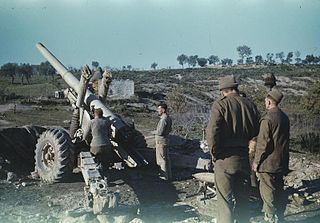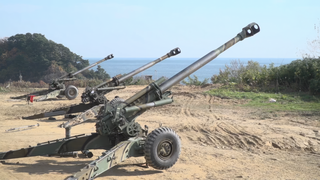
The M102 is a light, towable 105 mm howitzer used by the United States Army in the Vietnam War, the Gulf War, and the Iraq War.

The GC-45 is a 155 mm howitzer designed by Gerald Bull's Space Research Corporation (SRC) in the 1970s. Versions were produced by a number of companies during the 1980s, notably in Austria and South Africa.

The LG1 is a modern 105 mm towed howitzer designed and produced by GIAT Industries of France.

The BL 5.5-inch gun was a British artillery gun introduced during the Second World War to equip medium batteries.

The M114 is a towed howitzer developed and used by the United States Army. It was first produced in 1941 as a medium artillery piece under the designation of 155 mm Howitzer M1. It saw service with the US Army during World War II, the Korean War, and the Vietnam War, before being replaced by the M198 howitzer.

The FH70 is a towed howitzer used by several nations.

The M119 howitzer is a lightweight 105 mm howitzer, used by the United States Army. It is the American licensed version of the British L119 light gun. The M119 is typically towed by the M1097 or M1152 High Mobility Multi-Purpose Wheeled Vehicle (HMMWV), and can be easily airlifted by helicopter, or airdropped by parachute.

The L118 light gun is a 105 mm towed howitzer. It was originally designed and produced in the United Kingdom for the British Army in the 1970s. It has since been widely exported. The L119 and the United States Army's M119 are variants that use a different type of ammunition.

The M101A1 howitzer is an artillery piece developed and used by the United States. It was the standard U.S. light field howitzer in World War II and saw action in both the European and Pacific theaters and during the Korean War. Entering production in 1941, it quickly gained a reputation for accuracy and a powerful punch. The M101A1 fires 105 mm high explosive (HE) semi-fixed ammunition and has a range of 12,330 yards (11,270 m), making it suitable for supporting infantry.

The M108 howitzer is an American self-propelled 105 mm howitzer, first introduced in the early 1960s as a replacement for the M52 self-propelled howitzer.

The OTO-Melara Mod 56 is an Italian-made 105 mm pack howitzer built and developed by OTO Melara. It fires the standard US type M1 ammunition.
Ares Incorporated is an American weapons manufacturer and firearms engineering company co-founded by the American weapons inventor and developer Eugene Stoner in 1971. The company is based in Port Clinton, Ohio, and produces fire control systems, turret systems, small arms, automatic cannons and industrial machinery. Mr. Stoner left the company in 1989, joining Knight's Armament Company in 1990, where his designs included the Stoner 96, a further refinement of the Ares LMG/Stoner 63.

Hyundai WIA Corporation, formerly known as WIA is a member of the Hyundai Motor Group and is the second biggest automotive parts manufacturer in South Korea. As one of the core companies of Hyundai Motor Group, it is supplying automobile engines, modules, C.V Joint and 4WD systems to automobile companies such as Hyundai, Kia, and Genesis. In addition, it is in charge of manufacturing and selling FA facilities, various large-caliber artillery, aircraft parts, robots, and press device. The main customers who earn most of their sales are Hyundai, Kia, Genesis, and the Ministry of National Defense.

The HM-41 is an Iranian 155 mm howitzer based on the South Korean KH179, which was sold to Iran during the Iran–Iraq War. It has a 155 mm/39 caliber barrel with a muzzle brake to lessen the recoil.
105 mm is a common NATO-standard artillery and tank gun calibre. The rifled tank round is defined by STANAG 4458. The artillery round is defined by AOP-29 part 3 with reference to STANAG 4425.

The CN08 is a 120 mm 55-caliber smoothbore tank gun produced by Hyundai WIA. It is incorrectly known as the licensed production of the Rheinmetall Rh-120 L/55, but it was indigenously developed by the Agency for Defense Development and WIA from 2003 to 2008 for the XK2 development project started in 1995. The development was completed after the field test ended in September 2008.

The KH179 is a South Korean 155 mm towed howitzer of length 39 calibers, designed and developed by the Agency for Defense Development (ADD) for the Republic of Korea Armed Forces, and is now manufactured by Hyundai WIA.
















